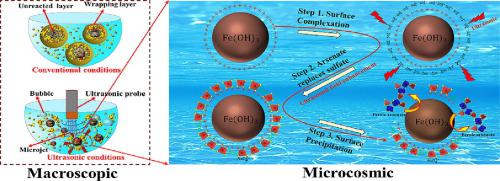Separation and Purification Technology ( IF 8.6 ) Pub Date : 2023-06-05 , DOI: 10.1016/j.seppur.2023.124258 Qi Zhang , Hongying Xia , Yingjie Xu , Guiyu Jiang , Wuchen Cai , Libo Zhang

|
Arsenic in zinc sulfate solution greatly hinders the zinc hydrometallurgy process, and the treatment of arsenic residue with lime also generates large cost due to the large amount of residue. Herein, a new process of neutralization by zinc roasting dust (ZRD) and ultrasound (US) field enhancement of arsenic removal was proposed. The process includes the following steps:one-stage neutralization, KMnO4 oxidation and two-stage neutralization to remove arsenic. The process has the advantages of a good arsenic removal effect, no introduction of new impurities, and less residue. The effects of the ZRD dosage, temperature and US power on arsenic removal were investigated. The optimal conditions were 12 g/L, 70 ℃ and 300 W, respectively, and the arsenic removal rate reached 99.3%. The X-ray powder diffraction (XRD), Fourier transform infrared spectroscopy (FT-IR), X-ray photoelectron spectroscopy (XPS) and field emission scanning electron microscopy (FE-SEM-EDS) were utilized to analyze the raw materials and residue. The results showed that, compared with conventional conditions, US strengthening treatment led to more complete reaction of ZRD. The arsenic removal residue after US treatment mainly existed in the form of ZnFe2O4, Fe3O4 and ZnS, which exhibited low reactivity. Ultrasound could effectively destroy the wrapper on the surface of ZRD, and enhance the liquid–solid reaction, which reduced the amount of residue and improved the arsenic removal efficiency. Interestingly, we found that ultrasound could enhance arsenic removal by increasing the ligand exchange between arsenate and sulfate. Compared with the lime and conventional ZRD neutralization, the wet residue weight after US treatment was reduced by 46.8% and 16.3%, respectively.
中文翻译:

锌焙烧灰超声强化中和去除硫酸锌溶液中有毒砷(As)的机理
硫酸锌溶液中的砷极大地阻碍了湿法冶炼锌工艺,而用石灰处理砷渣也因渣量大而产生较大的成本。在此,提出了一种锌焙烧粉尘中和和超声波场增强除砷新工艺。该工艺包括以下步骤:一级中和,KMnO 4氧化和两级中和去除砷。该工艺除砷效果好,无新杂质引入,残渣少。研究了 ZRD 用量、温度和美国功率对除砷的影响。最佳条件分别为12 g/L、70 ℃和300 W,除砷率达到99.3%。采用X射线粉末衍射仪(XRD)、傅里叶变换红外光谱仪(FT-IR)、X射线光电子能谱仪(XPS)和场发射扫描电子显微镜(FE-SEM-EDS)对原料和残渣进行分析. 结果表明,与常规条件相比,US强化处理导致ZRD反应更完全。US处理后的除砷渣主要以ZnFe 2形式存在O 4、Fe 3 O 4和ZnS,表现出低反应性。超声波能有效破坏ZRD表面的包裹物,增强液固反应,减少残渣量,提高除砷效率。有趣的是,我们发现超声波可以通过增加砷酸盐和硫酸盐之间的配体交换来增强砷的去除。与石灰和常规ZRD中和相比,US处理后的湿渣重量分别降低了46.8%和16.3%。



























 京公网安备 11010802027423号
京公网安备 11010802027423号